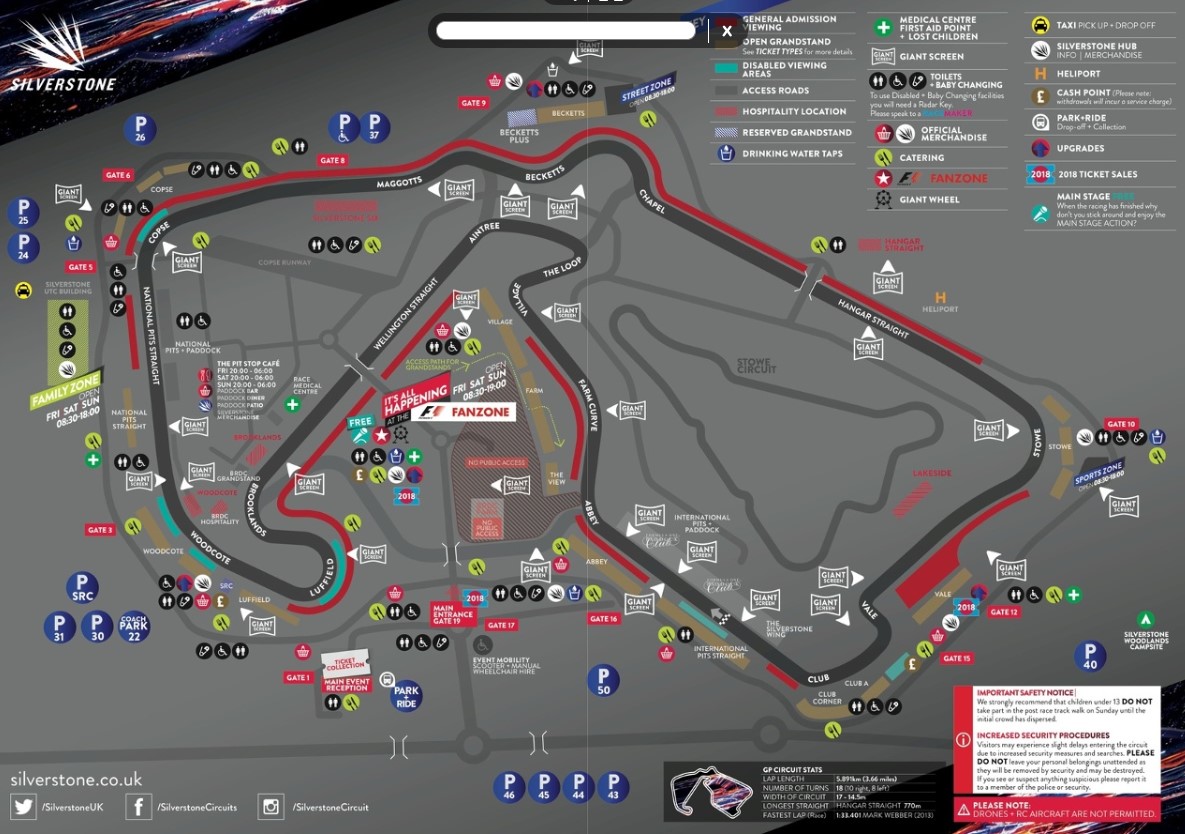British GP Preview
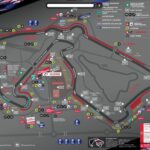 |
| Silverstone |
A rolling stone gathers no moss, and coming into Silverstone Circuit for Sunday’s British Grand Prix, Haas F1 Team is rolling.
In only its third year competing in the FIA Formula One World Championship, Haas F1 Team is an impressive fifth in the constructors’ standings nine races into the 21-race calendar. Its tally of 49 points so far this season surpasses its total from all of last year, where it finished eighth in points.
Drivers Romain Grosjean and Kevin Magnussen delivered Haas F1 Team’s best collective result last Sunday in the Austrian Grand Prix when Grosjean finished fourth and Magnussen came home fifth. The haul of 22 points allowed Haas F1 Team to leapfrog Force India and McLaren in the constructors’ ranks and sit within striking distance of the factory Renault effort, which occupies a best-of- the-rest fourth-place standing behind the powerhouse trio of Scuderia Ferrari, Mercedes and Red Bull. Thirteen points separates Haas F1 Team from Renault, while the American squad has a five-point margin over sixth-place McLaren, a seven-point gap to seventh- place Force India and a 30-point advantage over eighth-place Toro Rosso.
Twelve races still remain in 2018, meaning the advantages and deficits to other teams can still ebb and flow before the curtain drops on Formula One’s 72nd season. That means there’s no let-off for the Haas Automation-sponsored team, which is appropriate considering they’re coming into a venue where drivers rarely let off the throttle.
Silverstone is considered one of Formula One’s power circuits. The 5.891-kilometer (3.660-mile), 18-turn track that is roughly a two- hour drive from London is one of the series’ fastest venues, with an average speed of around 230 kph (143 mph). It is the third longest track on the Formula One schedule, behind only Circuit de Spa-Francorchamps (7.004 kilometers, 4.352 miles) and Baku City Circuit (6.003 kilometers, 3.730 miles). The majority of its layout is comprised of medium- and high-speed corners, allowing drivers to run at full-throttle for 70 percent of their lap. Teams run medium to high levels of downforce in their racecars to better assist with the impressive cornering speeds achieved on the track’s sweeping corners. The circuit has relatively few long straights, making these downforce levels achievable.
Achievement is always at the top of Haas F1 Team’s to-do list. After back-to-back eighth-place finishes in the constructors’ standings in its first two years of existence, Haas F1 Team seeks a higher standing among Formula One’s hierarchy. Founder and chairman Gene Haas proved this point by laying down an edict at the beginning of the season when he said, “We need to be within a half-second of the Ferraris in order for us to be competitive. We weren’t last year. I would say we were a second to a second-and-a-half slower than the Ferraris. Overall, we were maybe two seconds off the pole qualifiers, so we need to knock a second off that if we really want to be competitive."
As the series nears its halfway mark, call it message delivered. The pace Haas F1 Team first displayed during the chill of preseason testing in late February and early March at Circuit de Barcelona – Catalunya has carried into the sweltering heat of summer. Haas F1 Team’s fortunes have risen in concert with the mercury, and with the calendar turning to July, there’s no let-off in sight.
Guenther Steiner, Team Principal, Haas F1 Team
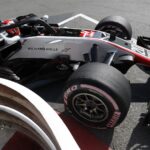 |
| The powerful Ferrari engine is making the Haas team look good |
Haas F1 Team has enjoyed its best results this year at power circuits – fourth last Sunday in Austria, fifth in Bahrain and a pair of sixth-place results in Spain and France. Do those performances heighten your expectations for how the team will perform at Silverstone?
“Our car seems to be best at high-speed circuits, and with Silverstone being one of them, for sure we’re hoping to have a good result there, as well."
What is it that makes the Haas VF-18 so good at power circuits compared to shorter, more compact tracks?
“I think it’s just the aero characteristics. Some cars like slow circuits, some like fast corners, and ours seems to like the fast corners a lot better than the slow ones."
Silverstone is a fast track where drivers are able to run full throttle for long periods of time. How do you help them find that edge to determine when they can be flat out and when they can’t?
“They find that edge themselves. If the engineering team gives them a good, stable car, they are not afraid to go flat-out. But they need to be confident that the car will do what they want the car to do, and that is down to the engineering team."
Weather tends to be a large variable at Silverstone, with hot weather interspersed with cool, blustery and even raw conditions. How do you prepare for temperature swings and weather changes, be it at Silverstone or anywhere else?
“Other than having data together for the tires and how they work in the different temperatures, it’s honestly hard to prepare. The best we can do is keep our eye on it and go with what the weather gives us."
With Haas F1 Team’s European base being in Banbury, England – about 30 minutes away from Silverstone – how helpful is this location for personnel and for logistics as we near the end of this unprecedented stretch of three straight races?
“Most of the guys are based near the circuit or their home is near Banbury, so it’s actually quite nice for them as most can go sleep in their own bed. Nevertheless, they need to get up early to get into Silverstone and they come back late. With three events in a row, it’s quite good that it’s the last one, for at least they’re near to home."
Romain Grosjean, Driver No. 8, Haas F1 Team
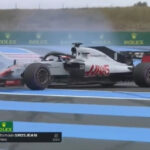 |
| Romain Grosjean |
Silverstone is one of the fastest tracks in Formula One, but it’s not necessarily from long straights but rather from long, flowing corners. Can you describe the feeling of speed you experience at this power circuit?
“It’s a really cool track, especially the fast part through Maggotts, Becketts and Chapel corners. When you have the grip in the car there, you really get the sensation of the g-forces. Everything’s pushing down. You really want to get the first part of the flowing corners right. If you don’t, you just lose a lot of time. When the car is very stable and has good balance, you can go flat-out and really push it to the limit."
With speed playing such a role at Silverstone, how difficult is it to overtake? And if the opportunity presents itself, where can you overtake?
“There are a few spots. On the straights and through the high-speed corners, you have an opportunity if your car is much better balanced than the car in front of you. After turn three or turn four, there’s the long section after the slow-speed corners, and that’s a good opportunity, as well. But the thing about Silverstone is really the difference between a well-balanced car and an unbalanced car – that’s where the opportunity lies."
What do you need at Silverstone to have the proper balance in your racecar?
“Silverstone is not an easy track. You’ve got all the high-speed sections, where you really want to carry some speed and get fast. Then you’ve got the twisty turns three and four, then the whole last corner, which is tricky on the throttle application. Generally, you need a good rear-end, and if you get that, you can then put some front-flap on and go faster."
Is Silverstone the track where you’re able to run at full throttle for the longest periods of time?
“I think probably Baku is where we’re flat-out for longer periods of time, but Silverstone is a power track, as well. You need good power to get a good lap time there. There are a few straight lines and a few overtaking opportunities but, mainly, Silverstone is about the grip of the car through the high-speed corners."
How do you find that edge to determine when you can be flat-out and when you can’t?
“Well, you find out quickly when you’re wrong, but you have to try. It’s as simple as that. You go step-by-step, but definitely the last step is going flat-out."
At most circuits, pole position is critical. But for some reason, not as much at Silverstone, where the pole winner has only gone on to win six times in the last 20 years. Is this happenstance or is there something about the track’s layout that provides more opportunity for those a little deeper on the starting grid?
“Silverstone is in the UK, and the UK weather is known to be sometimes rainy, sometimes dry. That plays a part. It can change a lot between qualifying and the race, and then even in the race itself. You can also have a good car in qualifying, but if it’s not quite perfectly balanced for the race, you’ll pay the price. That’s where success lies, and probably why most of the winners didn’t start from pole position."
Do you have any milestones or moments from your junior career that you enjoyed at Silverstone?
“I’ve had some good races there. I remember GP2 in 2009 – I scored the pole position by a big margin, and that was pretty good fun. In F1, back in 2012, I had a first-lap incident where I had to change the front wing and from there I just pushed all the way. I remember overtaking (Jenson) Button and (Lewis) Hamilton through Maggots, Becketts – the high-speed corners. I came back to sixth from being last on the first lap, which was pretty good."
What is your favorite part of Silverstone?
“The high-speed corners at Maggotts, Becketts and Chapel."
Explain a lap around Silverstone, especially now after having competed there with the faster, current-generation car. “Silverstone is a very high-speed circuit. The new cars make it very different, especially through all the high-speed corners – it’s very sexy. Turn nine, the old turn one, is flat out. It’s pretty amazing when you think about it. That’s really the biggest difference, although sector one hasn’t changed that much, but going into turn nine, and then 10, 11 and 12, and Stowe corner is very fast."
Romain Grosjean: British Grand Prix History
|
Year |
Track |
Car No. |
Team |
Start |
Finish |
Status/Laps |
Laps Led |
|
2017 |
Silverstone Circuit |
8 |
Haas F1 Team |
10 |
13 |
Running, 50/51 |
0 |
|
2016 |
Silverstone Circuit |
8 |
Haas F1 Team |
13 |
20 |
Transmission, 17/52 |
0 |
|
2015 |
Silverstone Circuit |
8 |
Lotus F1 Team |
12 |
18 |
Accident, 0/52 |
0 |
|
2014 |
Silverstone Circuit |
8 |
Lotus F1 Team |
11 |
12 |
Running, 51/52 |
0 |
|
2013 |
Silverstone Circuit |
8 |
Lotus F1 Team |
7 |
19 |
Running, 51/52 |
0 |
|
2012 |
Silverstone Circuit |
10 |
Lotus F1 Team |
9 |
6 |
Running, 52/52 |
0 |
Kevin Magnussen, Driver No. 20, Haas F1 Team
 |
| Kevin Magnussen |
Silverstone is one of the fastest tracks in Formula One, but it’s not necessarily from long straights but rather from long, flowing corners. Can you describe the feeling of speed you experience at this power circuit?
“Silverstone is definitely one of the good circuits. It’s really fast and you’ve got some big sections with fast changes of directions. I really enjoy driving the circuit."
Knowing how fast these current-generation cars are, how does the car feel at Silverstone, particularly through the Maggots, Becketts and Chapel corners – an area of the track where you really feel the g-forces being exerted on your body?
“Silverstone is probably one of the best circuits for these new cars. It’s a real downforce circuit with lots of high-speed corners. We all know that high-speed corners are the most impressive in a Formula One car, and Silverstone is all about that."
With speed playing such a role at Silverstone, how difficult is it to overtake? And if the opportunity presents itself, where can you overtake?
“I haven’t seen how the DRS zones are this year, whether they’ve changed them or not. If they haven’t changed them, then Silverstone is actually a challenging circuit to overtake . It’s all so high speed, so it is quite difficult to follow other cars. You do have some good straights, so if you’re a good chunk faster, then you will be able to overtake, but it’s not going to be easy."
Your teammate mentioned that the difference at Silverstone comes down to the opportunity between having a well-balanced car and an unbalanced car. What do you need at Silverstone to have the proper balance in your racecar?
“You need good high-speed balance as most of the corners are high speed."
At most circuits, pole position is critical. But for some reason, not as much at Silverstone, where the pole winner has only gone on to win six times in the last 20 years. Is this happenstance or is there something about the track’s layout that provides more opportunity for those a little deeper on the starting grid?
“I think it’s just by chance."
Do you have any milestones or moments from your junior career that you enjoyed at Silverstone?
“I won at Silverstone in F3 and World Series by Renault – all the categories I raced there. I can’t really say which one was the best one, but I remember they were all good."
What is your favorite part of Silverstone?
“Maggots and Becketts because they’re the high-speed turns."
Explain a lap around Silverstone, especially now after having competed there with the faster, current-generation car.
“Silverstone is mega-fast, a flowing and exciting circuit.
Kevin Magnussen: British Grand Prix History
|
Year |
Track |
Car No. |
Team |
Start |
Finish |
Status/Laps |
Laps Led |
|
2017 |
Silverstone Circuit |
20 |
Haas F1 Team |
16 |
12 |
Running, 50/51 |
0 |
|
2016 |
Silverstone Circuit |
20 |
Renault Sport F1 |
16 |
17 |
Gearbox, 49/52 |
0 |
|
2014 |
Silverstone Circuit |
20 |
McLaren |
5 |
7 |
Running, 52/52 |
0 |
The Track: Silverstone Circuit
-
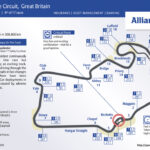
Silverstone Total number of race laps: 52
-
Complete race distance: 306.198 kilometers (190.263 miles)
-
Pit lane speed limit: 80 kph (50 mph)
-
This 891-kilometer (3.660-mile), 18-turn circuit has hosted Formula One since 1950, with last year’s British Grand Prix serving as the venue’s 51st grand prix.
-
Lewis Hamilton holds the race lap record at Silverstone (1:30.621), set last year with
-
Lewis Hamilton holds the qualifying lap record at Silverstone (1:26.600), set last year with Mercedes during
-
With an average speed of around 230 kph (143 mph), Silverstone is considered a power circuit and one of Formula One’s fastest tracks. The majority of its layout is comprised of medium- and high-speed corners, allowing drivers to run at full-throttle for 70 percent of their lap. Teams run medium to high levels of downforce to better assist with the impressive cornering speeds. These downforce levels are achievable because the circuit has relatively few long straights. Its sweeping corners provide overtaking opportunities, albeit tricky ones due to the speeds drivers can
-
DYK, Part I? The iconic gold trophy awarded to the winner of the British Grand Prix is the RAC Cup, and it is the oldest prize awarded in Formula Unlike other trophies, the winner doesn’t get to keep it. It’s returned soon after the podium celebration.
-
DYK, Part II? There are 18 turns at Silverstone, and each has its own name and
-
Abbey (turn one): This flat-out first turn was named after the ancient Luffield Abbey, the remains of which were found near the corner. The abbey was founded prior to 1133 and suppressed by King Henry VI in
-
Farm (turn two): This is a lazy left hander and the point where cars enter back onto the track from the The origins of its name are simple – the straight used to pass close to a nearby farm.
-
Village (turn three): One of the new corners introduced in 2010 following Silverstone’s redevelopment, this right hander is named after Silverstone Village, which lies to the north of the
-
The Loop (turn four): This is the only corner at Silverstone named for its shape, and drivers navigate it at 95 kph (60 mph), making it the slowest corner on this high-speed
-
Aintree (turn five): Famous for hosting the Grand National horse race, Aintree also staged the British Grand Prix in the 1950s and early 1960s and, in tribute, the left hander leading onto the Wellington Straight now bears the venue’s
-
Wellington Straight: Formally known as the National Straight, the run down to Brooklands was renamed in 2010 when it became part of Silverstone’s new grand prix layout. The Wellington Straight takes its name from the Wellington bombers that were based at the Northamptonshire circuit during World War Fittingly, the straight is formed from one of the old runways.
-
Brooklands (turn six): In the days of pre-war motor racing, Brooklands was Britain’s No. 1 venue. It makes sense that one of the corners at the modern-day home of British motorsport is named in the old track’s
-
Luffield (turn seven): Like Abbey, the long right hander was named after Luffield Introduced to Silverstone’s grand prix layout ahead of the 1991 race, Luffield was originally two distinct corners, known as Luffield 1 and Luffield 2.
-
Woodcote (turn eight): The Royal Automobile Club (RAC) was responsible for organizing the first major races at Silverstone. As such, the group had major influence in naming many of the track’s original Woodcote, the sweeping right hander which used to end the lap, is named after Woodcote Park, an RAC-owned club in Surrey.
-
Copse (turn nine): Silverstone is surrounded by luscious green fields and small pockets of dense woodland, knowns as copses. The quick Copse corner, which was the circuit’s first turn for nearly 60 years, passes especially close to Chapel Copse and Cheese Copse, hence its
-
Maggotts, Becketts and Chapel (turns 10-14): Approached at around 300 kph (186 mph), Silverstone’s fastest and most iconic sequence of corners was three distinct bends until Today, they are interlinked. The opening section, Maggotts, was named for nearby Maggot Moor. Becketts and Chapel Curve, meanwhile, take their names from the medieval chapel of St. Thomas à Beckett, which was built in memory of the murdered Archbishop of Canterbury and once stood near the corners. The chapel buildings were demolished in 1943 to make way for Silverstone airfield.
-
Hangar Straight: Silverstone’s use as a Royal Air Force base meant that it was once home to several large Two of the largest stood next to what became the circuit’s backstraight, which today is tackled at more than 325 kph (202 mph).
-
Stowe (turn 15): Situated at the end of Hangar Straight, the rapid right hander has always been a challenge for drivers despite several changes over the years. Like so many other corners at Silverstone, it takes its name from a nearby landmark, Stowe School, which lies just south of the
-
Vale (turn 16): Built on an airfield, Silverstone is more or less flat, which is why the most undulating piece of track, found between Stowe and Club, was named Vale, which is another word for valley. However, some say the name is simply a reflection of the fact this portion of the track sits within the district of Aylesbury
-
Club (turns 17-18): Club is the track’s final Like Woodcote, Club was named in honor of the RAC’s famous clubhouse in Pall Mall, London.
-
-
During the course of this weekend’s British Grand Prix, lows will range from 13-14 degrees Celsius (56-57 degrees Fahrenheit) to highs of 27-29 degrees Celsius (81-84 degrees Fahrenheit). Relative humidity ranges from 52 percent (mildly humid) to 95 percent (very humid), with a dew point varying from 9 degrees Celsius/49 degrees Fahrenheit (dry) to 15 degrees Celsius/59 degrees Fahrenheit (comfortable). The dew point is rarely below 7 degrees Celsius/45 degrees Fahrenheit (dry) or above 17 degrees Celsius/63 degrees Fahrenheit (mildly humid). Typical wind speeds vary from 2-21 kph/1-13 mph (light air to moderate breeze), rarely exceeding 27 kph/17 mph (moderate breeze).
Where the Rubber Meets the Road
-
Pirelli is bringing the following three tire compounds to Silverstone:
-
P Zero Ice Blue hard – less grip, less wear (used for long-race stints)
-
This is the second hardest tire in Pirelli’s lineup and it’s designed for circuits that put the highest energy loadings through the tires via fast corners, abrasive surfaces or high ambient temperatures. The compound takes longer to warm up but offers maximum durability and low degradation, which means it frequently plays a key role in race
-
-
P Zero White medium – more grip, medium wear (used for shorter-race stints and for initial portion of qualifying)
-
This is a versatile compound, but it sits in the harder part of the spectrum. The White medium often comes into its own on circuits that tend toward high speeds, temperatures and energy loadings. It has an ample working range and is adaptable to a wide variety of
-
-
P Zero Yellow soft – highest amount of grip, highest amount of wear (used for qualifying and select race situations)
-
This is one of the most frequently used tires in Pirelli’s range, as it strikes a balance between performance and durability, with the accent on performance. It is a very adaptable tire that can be used as the softest compound at a high-severity track as well as the hardest compound at a low-severity track or street
-
-
The British Grand Prix is the first time these three compounds have been packaged together, as it marks the debut of the Ice Blue hard
-
The Yellow soft tire was used in the season’s first five races, and after a two-race hiatus, it returned to action for successive grands prix in Round No. 8 in France and Round No. 9 in Austria. This is only the fourth race for the White medium tire, with it previously seeing action in Round No. 2 in Bahrain, Round No. 3 in China and Round No. 5 in
-
Two of the three available compounds must be used during the race. Teams are able to decide when they want to run which compound, adding an element of strategy to the A driver can also use all three sets of Pirelli tires in the race, if they so desire. (If there are wet track conditions, the Cinturato Blue full wet tire and the Cinturato Green intermediate tire will be made available.)
-
Pirelli provides each driver 13 sets of dry tires for the race weekend. Of those 13 sets, drivers and their teams can choose the specifications of 10 of those sets from the three compounds Pirelli selected. The remaining three sets are defined by Pirelli – two mandatory tire specifications for the race (one set of Ice Blue hards and one set of White mediums) and one mandatory specification for Q3 (one set of Yellow softs). Haas F1 Team’s drivers have selected the following amounts:
-
Grosjean: one set of Ice Blue hards, three sets of White mediums and nine sets of Yellow softs
-
Magnussen: one set of Ice Blue hards, three sets of White mediums and nine sets of Yellow softs
-
-
Toto Talks Great Britain
 |
| Toto Wolff |
Motor racing can be very cruel – and it was incredibly so for us in Austria. Before the race in Spielberg, a few people in the paddock told me that it was going to be an easy 1-2 for us because we had the quickest car. But while qualifying was a good result, it's not until Sunday that points are awarded.
However, it is the tough times that help us grow as individuals and as a team – not the good ones. Motor racing taught us a lesson about humility on Sunday – even when you have the fastest car, even when you lead the first 12 laps with both cars, things run away from you very fast if you make mistakes. That's the competition we are in, the fights we embrace and what makes this sport such a brilliant challenge.
We tried to show the right character in defeat. We took full responsibility for our mistakes, which takes guts, and we will now analyze them and come back stronger from that learning. Both drivers were calm and showed true leadership. We have had the fastest and most reliable car in recent years – and they reminded us of that fact.
We come to Silverstone on the back of the worst weekend we've had in a very long time. We are determined to put up a hard fight on home turf and come back with a strong result – one that is worthy of our drivers' performance, our fans' passion and the Mercedes brand.
Featured this Week: Steering a Formula One car
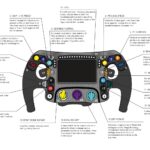 |
| Mercedes 2018 Wheel |
Formula One cars are incredible machines; they're fast, they're beautiful, they're the result of hundreds of people working together – and they are very complex. Yet, the drivers only have three ways of influencing the behavior of the car – the throttle pedal, the brake pedal and the steering wheel. In a way, the term "steering wheel" has become a bit misleading as "steering" is just one of many functions the device can perform these days – and it's not shaped like a wheel either. In this week's feature, we're taking a closer look at the complex command centers called steering wheels.
What are the main functions of a Formula One steering wheel?
In addition to the actual steering function, a Formula One steering wheel serves many purposes. One of the main functions is shifting, as the shift paddles and the clutch are mounted on the backside of the steering wheel. It's also a hub for information and communication. The driver can access crucial information on the central display, such as his engine speed, delta times to other cars or sensor information, for example tire temperatures. He can also confirm that he is coming into the pits with the press of a button and activate his radio. A total of 25 LED lights on the steering wheel inform the driver of different situations – from his shift points to a rendering of the marshalling flags. The steering wheel is also used to influence certain car settings, for example change the brake balance or adjust the differential (the amount of torque transfer between the rear wheels). Power unit settings, such as the all-important strategy mode, which determines the power output, are also selected on the steering wheel. Please find a detailed description of the different buttons in the attached infographics or on our media site: media.mercedesamgf1.com.
How can the team make sure the driver doesn't hit a button by accident?
When driven in anger, a Formula One car is subject to violent speeds and heavy vibrations – not exactly ideal conditions to manipulate small buttons on a steering wheel. To make it even more difficult, the drivers have to operate the steering wheel while wearing gloves. To reduce the risk of accidentally hitting a button, the team has installed small plastic rims around certain buttons. Those guards can change on a race-by-race basis. They are particularly important for tight turns like the hairpin in Monaco when the drivers use the maximum steering angle. In addition to the guards around the buttons, the team uses high reliability buttons that are also used on aircrafts, which require quite a strong tactile force. That way, the driver feels a solid click when he presses a button even with the gloves on.
How many steering wheel inputs does a driver make on a lap?
The amount and the type of inputs a driver makes depend on both the layout of the circuit and the situation in the session. On a "regular" race lap around Silverstone a driver will typically do around 40 gearshifts (the quickest sequence in about 1.2 seconds for five downshifts going into Turn 3), two brake balance adjustments, two changes of display page and three differential adjustments – all of that in addition to the actual steering, of course.
How many potential combinations of settings are there?
There are 16 buttons, six rotary wheels and three rotary switches on the steering wheel – in addition to the shift pedals and the clutch. This means that there are hundreds of millions potential combinations. But don't worry – our drivers don't have to test them all…
What does the development process of an F1 steering wheel look like and how involved are the drivers in that process?
When the main structure of today's wheel was designed, the drivers were heavily involved in the design process – both in the ergonomics of the wheel and in the physical layout (from the overall shape of the wheel to the way the grips form at the bottom). The carbon structure is a long-term component that usually carries over for one or two years. If a new structure is introduced, the team will run a number of prototypes and bring them to the track for the drivers to try out in Friday practice. During the season, the team will change the grips, the button and the switch layout and the guards around the buttons – based on the individual demands of the driver and the track layout.
How important are ergonomics in the design process?
Very important – both in terms the feel of the steering wheel as well as certain elements of comfort. Because a Formula One car is extremely tightly packaged, there is not a whole lot of space in the cockpit. The bigger the steering wheel, the more it will cut in on the clearance of the knees underneath it or the clearance of the knuckles on the side of the tub.
How long does it take to build a new steering wheel?
The actual build process takes about two weeks of working hours (i.e. 80 hours). The majority of the parts are build in-house, with the central display and the underlying circuit board being the only exception as those are common parts shared by all teams. All other components – the circuitry, the circuit boards, the steering, the carbon enclosure, the quick release, the electrical connectors – are custom build in the team's factory in Brackley. The main materials used in a steering wheel are carbon fiber, fiberglass, titanium, silicon and copper. Over the course of a season, each driver will get three to four wheels. Mechanical designers, electrical designers and wiring technicians are involved in the design and build process.
What is the biggest challenge in designing and building an F1 steering wheel?
The steering wheel is a safety-critical component (internally known as a Class A component). As such, it has to undergo rigorous testing – similar to, for example, a suspension element or a piece of the survival cell. However, at the same time it is a highly customized element, which can be changed on a race-by-race basis depending on the requirements of the drivers. The combination of these two requirements – highest level of diligence and constant changes – makes the design and build process very challenging.
How are steering wheels serviced?
Steering wheels go through a service every two or three races – and just like every other component on the car they have a certain maximum mileage. In the car, steering wheels are constantly vibrating and because they are considered safety-critical components, they undergo non-destructive testing (NDT) to make sure they don't suffer from any sort of cracking. To check for cracks, the wheels are submerged into a low viscosity dye penetrant and left the soak. The dye penetrates any cracks, which when dry will show clearly under ultraviolet light. The steering wheels also undergo electrical testing, ultrasonic inspection and checks for water tightness. The grips and buttons are also checked on a regular basis because every button only has a certain number of actuations it can survive.
